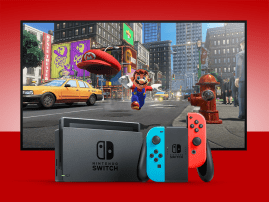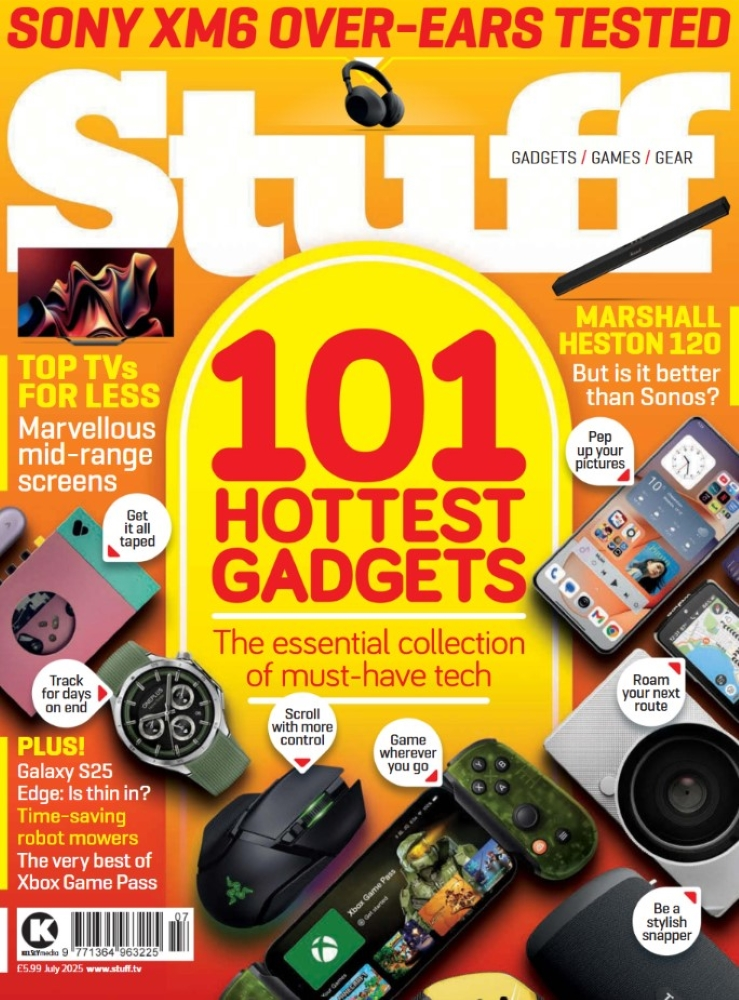Best gaming laptops in 2025 reviewed and ranked
Get your game on with these powerhouse laptops
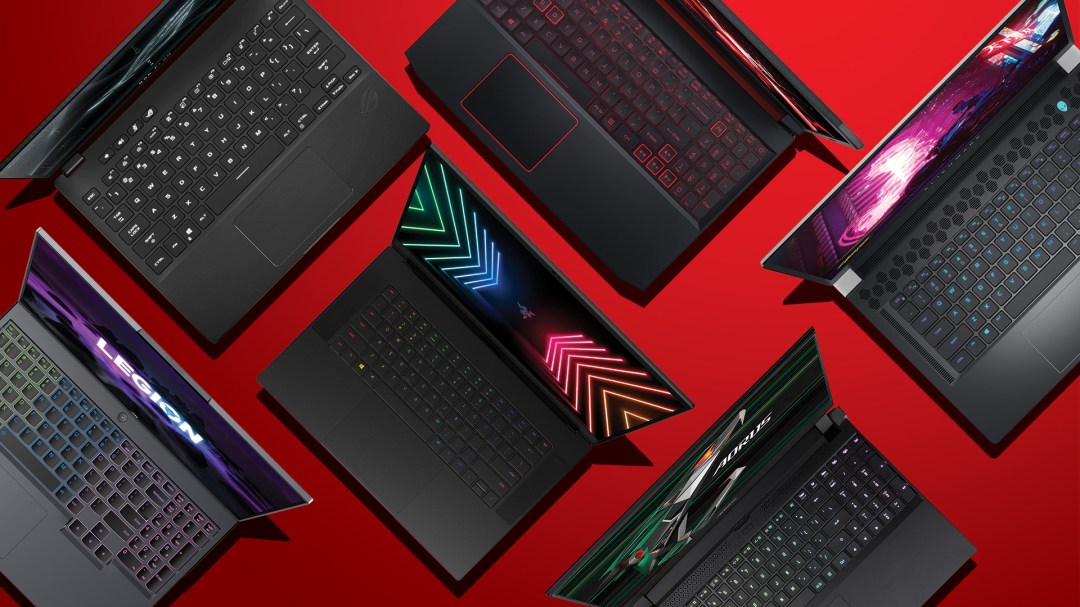
Finding the best gaming laptop to buy can be tricky. Do you want something not too expensive? Something on the slimmer side? Or do you want out-and-out gaming performance under the hood? From budget power performers to hardcore hardware, there’s a bewildering choice of the best laptops out there for serious gamers who need plenty of GPU horsepower.
Whatever you need, we’ve rounded up some of our favourite gaming laptops of the moment. There’s plenty of power for hardcore gamers out there and they’re all (reasonably) portable.
If you’re looking for a laptop to work on and watch the occasional film, check our our guide to the best laptops instead. But, without further ado, here are the best gaming laptops you can buy.
Why you can trust Stuff: Our team of experts rigorously test each product and provide honest, unbiased reviews to help you make informed decisions. For more details, read how we test and rate products.
Quick list: what is the best gaming laptop?
We think the MSI Titan GT77 HX 13V (buy now) is the best gaming laptop on the market. Designed as the sort of all-conquering laptop that’ll form the basis of your gaming life for years, the MSI Titan GT77 is one of the first models with the all-powerful Nvidia GeForce RTX 4090 inside.
The Lenovo Legion Slim 7i (buy now) is powerful enough for gaming, yet slim and stylish enough to take on the move. It is basically a capable all-rounder. This 16in stunner is thin and light enough to be your everyday work machine, yet underneath beats a heart that’s equal parts 12th-gen Intel Core i7 CPU and Nvidia 3060 dedicated graphics.
The Asus ROG Zephyrus G14 (buy now) is incredibly thin, impressively powerful, instantly lovable. The Asus ROG Zephyrus G14 (2024) is a simply fantastic gaming ultraportable.
The Acer Nitro 5 (buy now) might be a bit rough around the edges but offers outstanding value.
The Medion Erazer X40 Beast (buy now) somehow makes an expensive laptop seem like good value. This is about as little as you can hope to pay at the time of review for a laptop with an Nvidia RTX 4090 graphics card, 13th Gen Core i9 processor and 32GB RAM.
The Asus ROG Zephyrus G16 (buy now) is part uncompromising gaming laptop, part portable creative powerhouse. It’s a superb (and superbly expensive) machine that is up there with Apple MacBooks for slick construction.
The Razer Blade 16 Automobili Lamborghini Edition (buy now) is insanely quick, with a delectable screen and streamlined styling. If you’ve got the budget, it’s a superb gaming machine – and the regular model will please everyone else.
The Razer Blade 15 Advanced (buy now) is where brilliant design meets searing pace in a top-tier esports experience.
The Asus ROG Zephyrus M16 (buy now) has no shortage of gaming grunt, and the miniLED screen is amazing – but this slim, sturdy notebook will almost certainly be outpaced by beefier competitors.
The MSI Raider GE77 (buy now) is huge, heavy and expensive, but if you’ve got the cash then the MSI Raider GE77 delivers unprecedented power and impressive display quality.
The Lenovo Legion 5 Pro (buy now) provides a big-screen experience with the power for games and creative work.
The Asus TUF Gaming A15 (buy now) offers fantastic performance from gamer-friendly hardware that manages to stay on the right side of affordable. It also fares just as well for daily duties.
The best gaming laptops you can buy today:
Best gaming laptop overall
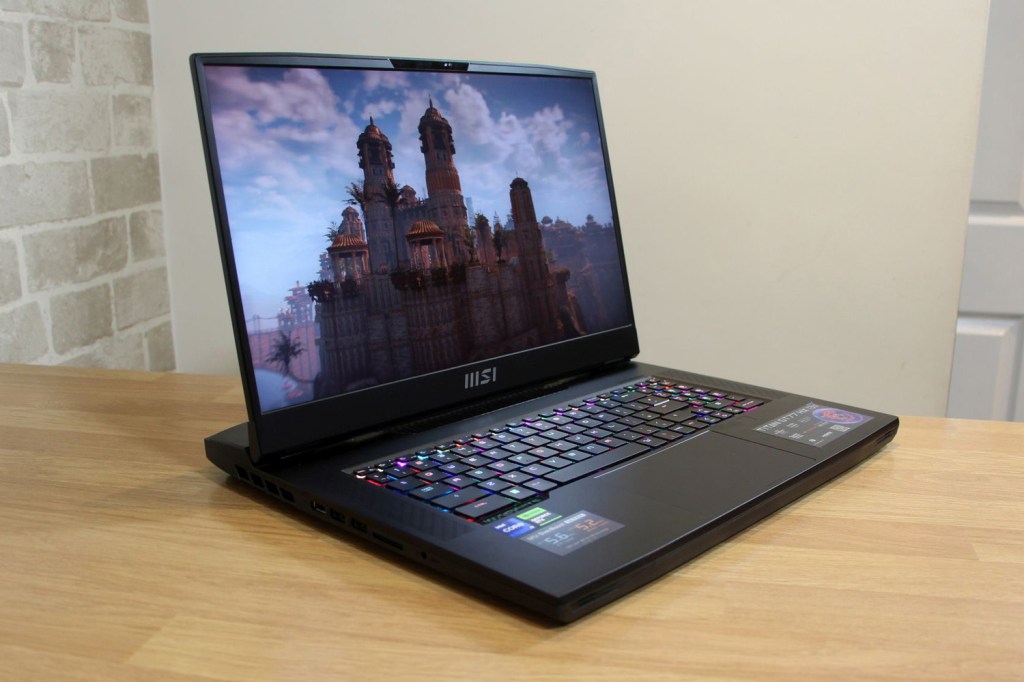
1. MSI Titan GT77 HX 13V
Stuff Verdict
Record-breaking speed and an amazing screen, but a ruinous price and design issues prevent a runaway victory.
Pros
- The fastest gaming laptop we’ve ever used
- Mini LED display looks sensational
Cons
- Costs an eye-watering amount
- Fan noise gets extreme
| MSI Titan GT77 HX 13V specs | |
|---|---|
| Screen | 17.3in 3840×2160 144Hz mini LED |
| CPU | Intel Core i9 |
| GPU | GeForce RTX 4090 16GB |
| RAM | 32GB |
| Storage | 2TB SSD |
| Battery | 1-5 hours |
| Dimensions | 37mm thick, 3.47kg / 1.46in, 7.65lbs |
Designed as the ultimate powerhouse for gaming enthusiasts, the MSI Titan GT77 is a laptop that could easily anchor your gaming setup for years to come. It’s one of the first we’ve had the pleasure of testing that features the mighty Nvidia GeForce RTX 4090 graphics card – an absolute beast of a dedicated GPU that has your games looking stunning while running at ultra-high frame rates. Whether you’re enabling HDR for those extra-vivid visuals or harnessing the magic of DLSS 3.0 to create AI-generated frames between each GPU-rendered one, this laptop delivers a phenomenal gaming experience.
Beyond the raw graphical power, the Titan GT77 is equipped with an incredible mini LED display, which enhances colour accuracy and brightness for a deeply immersive visual experience. It’s an all-out performance machine designed to push boundaries, and if you’re after maximum speed and exceptional image quality, this rig will more than meet your demands. However, all this comes with a hefty price tag – so steep that, for the same money, you could probably build a high-end gaming PC with an RTX 4090 and still afford a top-tier gaming monitor.
There are, unfortunately, a few trade-offs. While the performance is top-notch, the loud cooling fans can be a bit disruptive during intense gaming sessions. Plus, the keyboard, despite having some mechanical switches, only uses them for part of the layout, which feels a little underwhelming considering the premium price. But if you’re seeking the fastest gaming laptop on the market right now – and arguably the best screen available – the MSI Titan GT77 remains a compelling, if expensive, choice. It’s a laptop built to dominate the gaming world, but at a price that demands serious commitment.
- Read more: MSI Titan GT77 HX 13V (2023) review
Best gaming laptop for most people
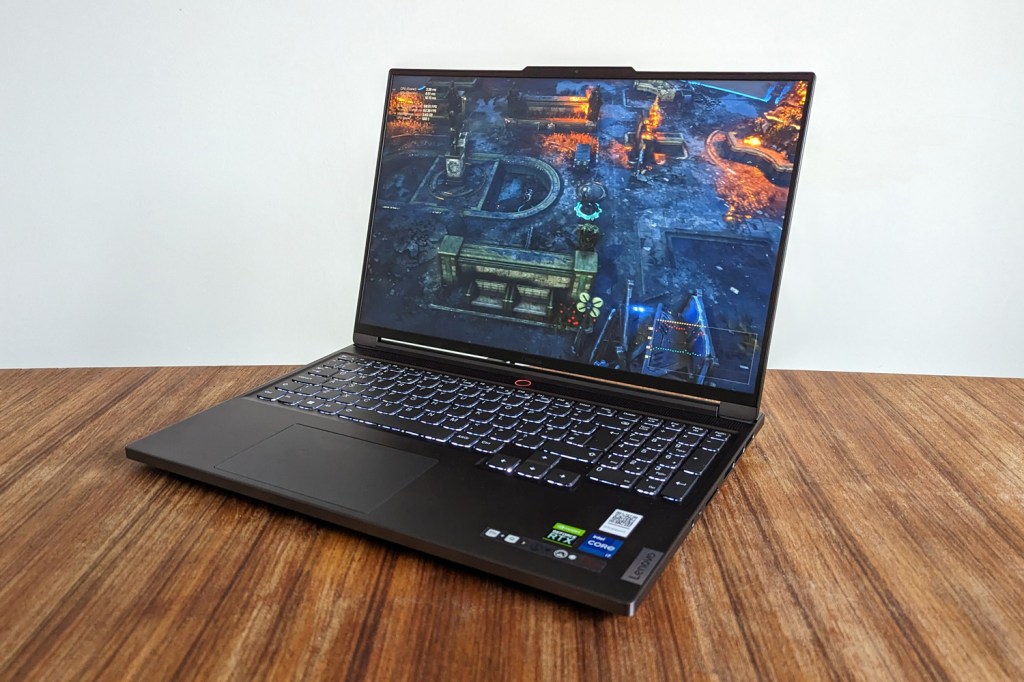
2. Lenovo Legion Slim 7i
Stuff Verdict
Powerful enough for gaming, yet slim and stylish enough to take on the move – this is a capable all-rounder. Just be sure to shop around, as the version tested isn’t the sweet spot of the lineup.
Pros
- Slim, sturdy build looks and feels classy
- Superb desktop performance
Cons
- RTX 3060 outmuscled by rivals
- Limited upgrade potential
| Lenovo Legion Slim 7i specs | |
|---|---|
| Screen | 16in, 2560×1600 LCD w/ 165Hz |
| CPU | Intel Core i7 |
| GPU | Nvidia RTX 3060 6GB |
| RAM | 16GB DDR5 |
| Stoarge | 1TB |
| Battery | Up to ten hours |
| Dimensions | 358x260x17mm, 2.17kg / 14.09 x 10.24 x 0.67in, 4.79lbs |
With its sleek design, high-quality screen, and enough desktop-level performance to handle both work and play, the Legion Slim 7i is a portable powerhouse that ticks all the right boxes. What we love about this machine is its subtlety – it boasts gaming pedigree, but without the flashy, in-your-face aesthetics of other gaming laptops. This makes it versatile enough to bring into the office without raising any eyebrows, while still offering impressive performance when it’s time to unwind with a game.
One standout feature for us is the impressive battery life. Lenovo has equipped the Slim 7i with clever GPU-swapping tech, which allows it to switch between the integrated and dedicated graphics cards depending on the task at hand, preserving battery life without sacrificing power. It’s this kind of smart design that makes the Slim 7i capable of handling just about anything you throw at it, from intense work sessions to demanding games.
Now, with Intel and Nvidia having launched their latest 13th-gen CPUs and 4000-series GPUs, prices for “older” models like this one have started to drop – making it an even more enticing option. You can now pick up a version of the Legion Slim 7i with an RTX 3070 Ti for around the same price as a rival like the Acer Predator Helios P300. And while those competitors are closely matched in terms of raw power, the Slim 7i pulls ahead with its superior portability.
Yes, the latest-gen processors and GPUs may be the talk of the town, but they come with a hefty price tag. The hardware inside the Legion Slim 7i isn’t far behind, and for the price, you’re getting a lot of bang for your buck. Grab one with the right spec, and we think you’ll find plenty to love about this versatile and powerful laptop.
- Read more: Lenovo Legion Slim 7i review
Best 14in gaming laptop
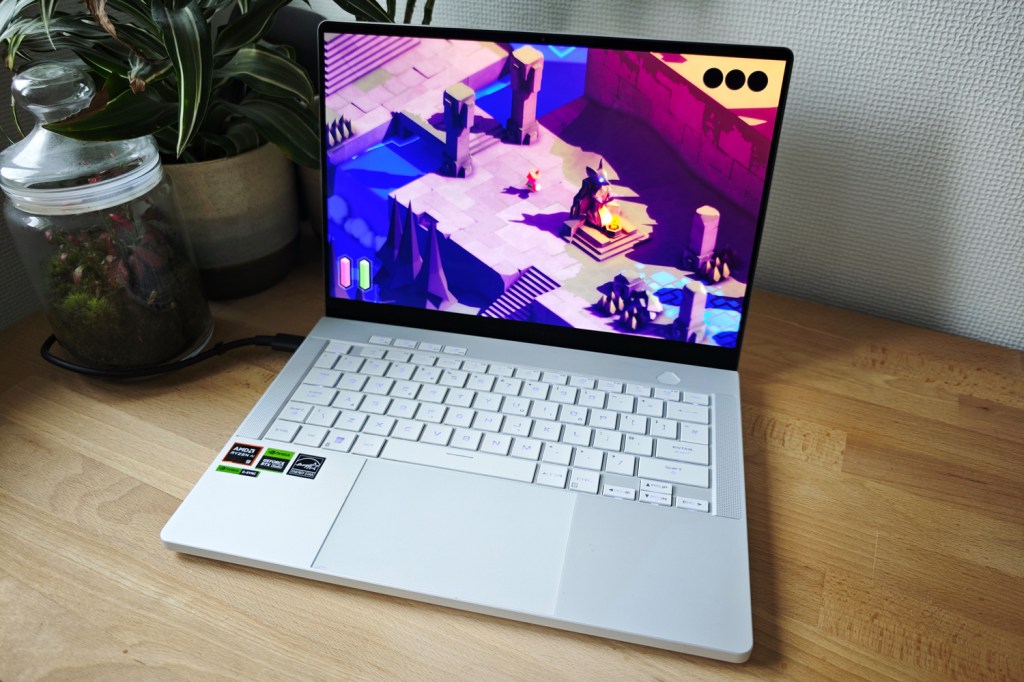
3. Asus ROG Zephyrus G14
Stuff Verdict
Incredibly thin, impressively powerful, instantly lovable. The Asus ROG Zephyrus G14 (2024) is a simply fantastic gaming ultraportable.
Pros
- OLED display is a beauty
- Serious amount of power in a small chassis
- Great connectivity for an ultraportable
Cons
- It’ll cost ya
- GPU power limited compared to thicker rivals
| Asus ROG Zephyrus G14 specs | |
|---|---|
| Screen | 14in, 2880×1800 OLED w/ 120Hz, G-sync |
| CPU | AMD Ryzen 9 8945HS octa-core |
| GPU | Nvidia GeForce RTX 4070 |
| RAM | 32GB RAM |
| Storage | 1TB PCIe Gen 4.0 NVMe SSD |
| Battery | 73Wh |
| Dimensions | 311x220x14.9mm, 1.5kg / 12.24 x 8.66 x 0.59in, 3.31lbs |
Asus may not be the first to create an all-metal gaming ultraportable—Razer blazed that trail years ago—but the Asus ROG Zephyrus G14 is the first one we’d genuinely consider swapping our current machines for. This laptop nails the balance between portability, power, and premium design. It’s compact, sleek, and has one of the most impressive screens we’ve ever seen on a gaming laptop, making it a real standout.
Of course, quality like this comes with a price tag, and the Zephyrus G14 isn’t exactly budget-friendly. But when you compare it to something like a 14-inch MacBook Pro with an M3 Pro chip, it’s clear where the G14 shines. While Apple continues to push the boundaries in some areas, gaming just isn’t its strong suit. The G14, on the other hand, offers a potent mix of portability and gaming performance. You can take it anywhere, and it’s capable of running pretty much any modern game – with just a few tweaks to the resolution and detail settings to keep things smooth. That kind of versatility is rare, especially in something this lightweight.
And then there’s the screen. The OLED display is an absolute game-changer, bringing out rich colours and deep contrasts that make gaming and work tasks equally stunning. It’s the sort of display that spoils you for anything else, honestly.
In terms of battery life, Asus has also nailed it. The G14’s battery holds up well enough to get through a typical workday, which isn’t something you can say for a lot of gaming laptops. All things considered, we’d be surprised if any other compact gaming laptop tops this one in the near future. The G14 is a winner in our books.
- Read more: Asus ROG Zephyrus G14 (2024) review
Best luxury gaming laptop
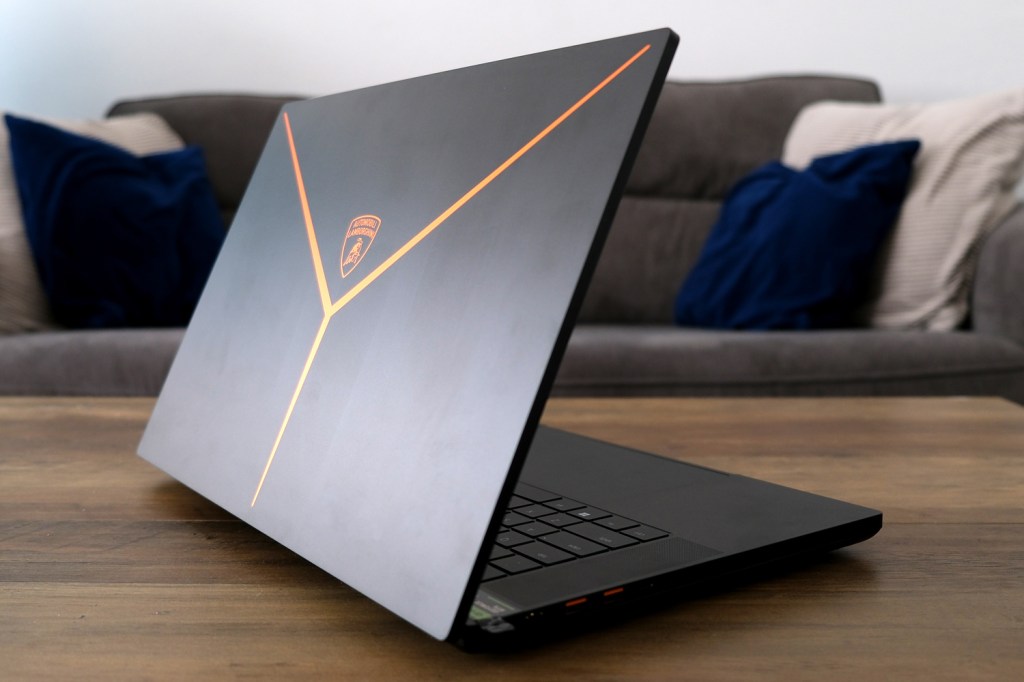
4. Razer Blade 16 Automobili Lamborghini Edition
Stuff Verdict
Limited-run Blade 16 is insanely quick, with a delectable screen and streamlined styling. If you’ve got the budget, it’s a superb gaming machine – and the regular model will please everyone else.
Pros
- Ridiculous 3D and desktop performance for a 16in laptop
- Gorgeous 4K HDR display that can do 240Hz Full HD on demand
- Stellar build with unique design elements
Cons
- Limited edition means it’ll be super rare
- Seriously expensive
| Razer Blade 16 Automobili Lamborghini Edition specs | |
|---|---|
| Screen | 16in, switchable 3840×2400 120Hz / 1920×1200 240Hz mini-LED |
| CPU | Intel Core i9-13950HX 24-core |
| GPU | Nvidia GeForce RTX 4090 w/ 16GB VRAM |
| RAM | 32GB RAM |
| Storage | 2TB PCIe NVMe SSD |
| Battery | 95.2wHr |
| Dimensions | 355x244x22mm, 2.45kg / 13.98 x 9.61 x 0.87in, 5.40lbs |
No one needs a Lamborghini sitting in their garage. A trusty hatchback will get you from A to B just fine. But, if you can afford one, a Lamborghini is undeniably a cooler, flashier, and more thrilling way to travel. The limited-run Razer Blade 16 is essentially the gaming laptop equivalent of that—an elite piece of kit with a staggering price tag of just under $5000. Is it necessary? Not in the slightest. Is it monstrously powerful, with performance that’ll make your friends’ jaws drop? Absolutely.
The display alone is worth shouting about. It’s so good, it can even put some top-tier gaming monitors to shame. The colours, the brightness, and the sheer smoothness make every game look phenomenal. It’s one of those experiences where you don’t realise what you’ve been missing until you see it for yourself.
Of course, the catch is exclusivity. Only 150 of these beauties are being made, and they’re all US-bound. If you’re not lucky enough to snag one, you’ll just have to admire it from afar, like a Lamborghini zooming past you on the highway.
But there’s a silver lining— the regular Razer Blade 16 is almost as powerful, and a bit more accessible, with a still eye-watering price of $4300/£4400 direct from Razer. If you’re savvy, you might even find it cheaper from third-party retailers. And while that’s still a major financial commitment, you’re getting a lot for your money. This machine combines insane power with sleek portability, making it the fastest laptop of its size. For those who crave top-tier gaming performance without sacrificing portability, it’s hard to argue against the price. After all, when you want the best, you pay for the best.
Best 16in gaming laptop
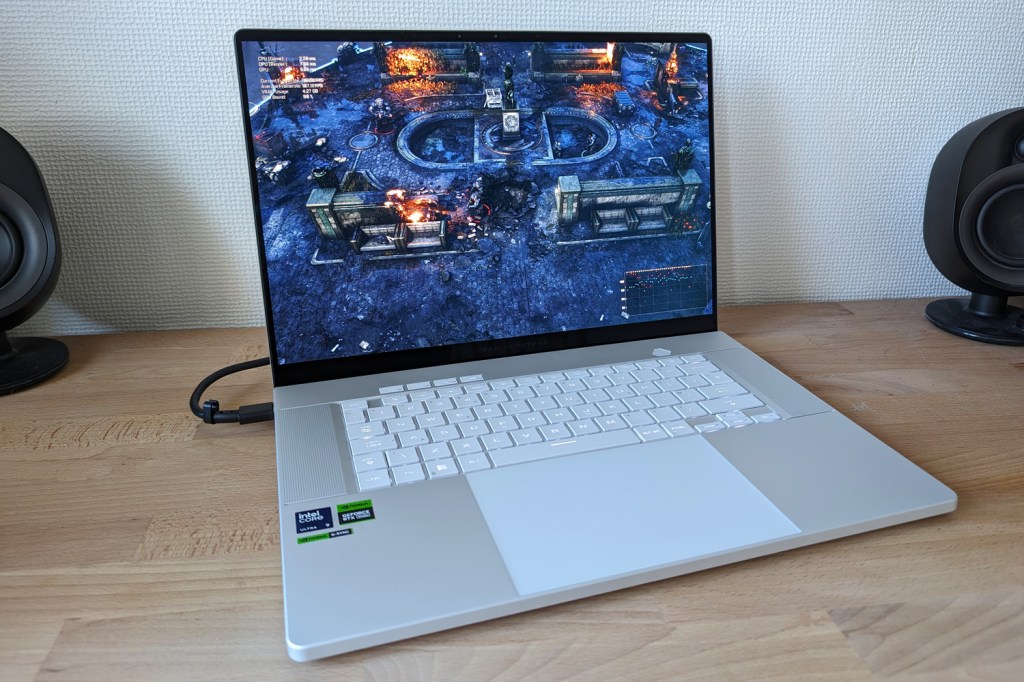
5. Asus ROG Zephyrus G16
Stuff Verdict
Part uncompromising gaming laptop, part portable creative powerhouse. The Asus ROG Zephyrus G16 is a superb (and superbly expensive) machine that is up there with Apple MacBooks for slick construction
Pros
- Top-tier gaming and desktop performance
- Outstanding OLED display
- Thin, light and with impeccable build quality
Cons
- Monstrously expensive in top spec
- Keyboard backlight hard to read on silver model
| Asus ROG Zephyrus G16 specs | |
|---|---|
| Screen | 16, 2560×1600 OLED w/ 120Hz, G-Sync |
| CPU | Intel Core Ultra 9 185H |
| GPU | Nvidia RTX 4090 |
| RAM | 16/32GB |
| Storage | 2TB SSD |
| Battery | 90WHrs |
| Dimensions | 354x246x14.9~17.4mm, 1.95kg / 13.94 x 9.69 x 0.59~0.69in, 4.30lbs |
If OLED screens are the new battleground for gaming laptops, Asus has definitely come out swinging with the ROG Zephyrus G16. Its panel resolution strikes a perfect balance – not quite 4K, so it doesn’t make the GPU break a sweat, but still sharp enough to look stunning in motion. Pair that with a buttery smooth 240Hz refresh rate, and games look so good it’s hard to tear your eyes away. This screen is a showstopper without being overly demanding on the hardware, which feels like a smart move for an ultra-portable gaming rig.
The new chassis is another highlight. It’s impressively thin and light, almost MacBook-like in its use of premium materials – not something you’d expect from a gaming laptop. Carrying it around doesn’t feel like lugging a brick, which is a win for anyone who’s constantly on the go. The silver model is especially stylish, though we have to admit, the keyboard and backlight combo could be a touch more legible. That said, the slash LED design on the lid? Absolutely sleek. It’s little touches like these that elevate the overall aesthetic.
We’re keen to see how it compares to Razer’s 2024 Blade 16, which also boasts a 240Hz OLED screen, but for now, the Zephyrus G16 holds its own. It’s especially impressive given its slim profile – though we can’t help but wonder if an RTX 4070 might be a better fit for such a compact machine, pushing performance without overheating.
For anyone who balances gaming at home with frequent work travel, this could very well be the perfect laptop. It’s powerful enough to handle the latest titles, portable enough to take on the road, and stylish enough that you’ll actually want to show it off. All the power, none of the bulk – sounds like a winner to us.
- Read more: Asus ROG Zephyrus G16 review
Best gaming laptop for durability
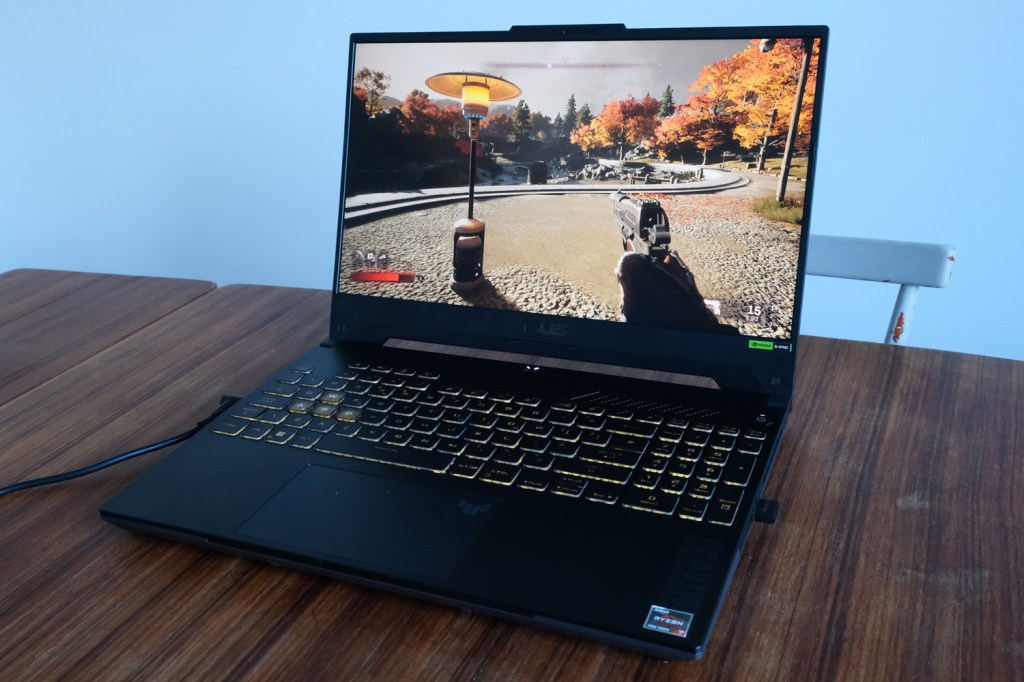
6. Asus TUF Gaming A15
Stuff Verdict
Fantastic performance from gamer-friendly hardware that manages to stay on the right side of affordable. The TUF Gaming A15 also fares just as well for daily duties.
Pros
- Great 1080p gaming performance
- Very respectable battery life
- Crisp high refresh rate screen
Cons
- Intel internals fare better at certain workloads
- Not everyone will like the ‘tough’ design
| Asus TUF Gaming A15 specs | |
|---|---|
| Screen | 15.6in, 1920×1080 IPS LCD w/ 144Hz |
| CPU | AMD Ryzen 7 7735HS |
| GPU | Nvidia GeForce RTX 4060 |
| RAM | 16GB RAM |
| Storage | 512GB NVMe SSD |
| Battery | 90Whrs |
| Dimensions | 354x251x22.4~24.9mm, 2.2kg / 13.94 x 9.88 x 0.88~0.98in, 4.85lbs |
The TUF Gaming A15 isn’t the absolute fastest 15-inch gaming laptop out there, and its Ryzen CPU won’t be breaking any performance records anytime soon – but for the price, it’s hard to argue with the value you’re getting. This machine offers a serious amount of bang for your buck, managing to run even the latest games comfortably at 1080p. Thanks to Nvidia’s clever DLSS technology, it’s future-proofed to handle upcoming releases too, which is impressive given its budget-friendly status.
While the display might not knock your socks off, it’s decent enough for casual gaming and streaming sessions, and the battery life is surprisingly solid – at least as long as you’re sticking to more lightweight tasks like web browsing or document editing. Try gaming without being plugged in, and you’ll drain the battery faster, but that’s pretty standard for most gaming laptops. Another bonus is the healthy number of ports, which means you won’t be juggling dongles just to connect your gear.
One of the standout features, though, is its durability. The A15 boasts ‘military standard’ toughness ratings, which, even if it’s more marketing hype than reality, still suggests this laptop is better equipped to handle the rigours of life on the road than some of its more fragile competitors. Whether you’re lugging it around campus, taking it to work, or just gaming on the go, it feels like it’s built to last.
Sure, if your budget stretches into the stratosphere, you can find something faster or flashier. But for the average gamer, it’s tough to find a better deal. This machine proves you don’t need to spend a fortune to enjoy solid performance, good features, and reliable durability. All in all, the TUF Gaming A15 is a lot of laptop for not a lot of money.
- Read more: Asus TUF Gaming A15 review
Best mechanical keyboard gaming laptop
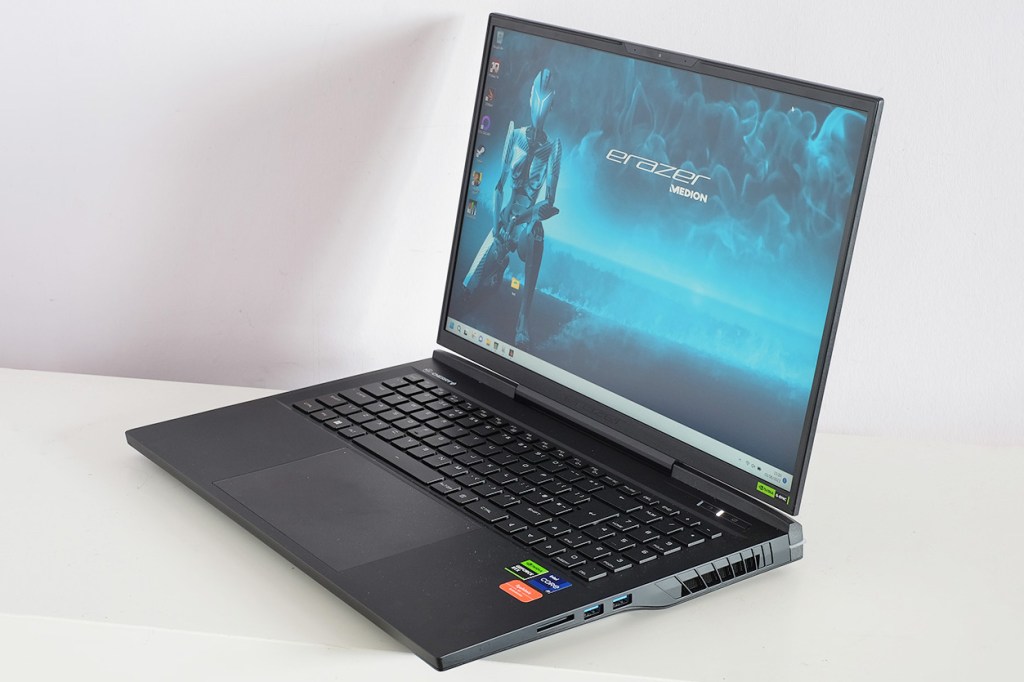
7. Medion Erazer X40 Beast
Stuff Verdict
It costs a fortune, but quality and performance are top-tier. There aren’t many cheaper laptops with these specs, yet Medion still packs in high-end touches like a mechanical keyboard.
Pros
- Epic performance for (relatively) good value
- Great mechanical keyboard & quality touchpad
Cons
- Display favours refresh over contrast and colour
- Short battery life despite massive battery
| Medion Erazer X40 Beast specs | |
|---|---|
| Screen | 16in, 2560×1600 LCD w/ 165Hz |
| CPU | Intel Core i7 |
| GPU | Nvidia RTX 3060 6GB |
| RAM | 16GB DDR5 |
| Storage | 1TB |
| Battery | Around 4.5 hours |
| Dimensions | 383x272x36mm, 2.82kg / 15.08 x 10.71 x 1.42in, 6.22lbs |
Medion has pulled off something quite remarkable with the Erazer X40 Beast. For such a high-end gaming laptop, it manages to make its hefty price tag seem almost reasonable. In fact, for the performance it offers, it might even be a bargain. At the time of review, this was one of the least expensive laptops featuring an Nvidia RTX 4090 graphics card, paired with a 13th Gen Intel Core i9 processor and a beefy 32GB of RAM. These are premium specs, yet you’d typically have to shell out hundreds more for the same hardware in a competing model.
What makes this even more impressive is that Medion hasn’t skimped on the design front. You’re getting premium touches like a Cherry MX mechanical keyboard, which is a dream for both gaming and typing, and a spacious glass touchpad that feels smooth and responsive. These are the kinds of features that give this laptop a serious edge, especially for the price.
Of course, not everything is perfect. The integrated speakers are a bit of a letdown, lacking the punch you’d expect in a gaming laptop. And while the 1080p webcam is serviceable, we’ve definitely seen sharper ones elsewhere this year. Another minor gripe is the fan noise. It’s not just the usual whooshing sound you’d expect – there’s a bit of a high-pitched whine in there too, which can get slightly annoying during extended gaming sessions. But these aren’t dealbreakers by any means, and they don’t detract much from the overall experience.
If you’re still on the fence, it’s worth checking out competitors like the HP Omen 17, which comes close in terms of pricing and performance. But for our money, the Erazer X40 Beast is hard to beat when it comes to delivering high-end specs without breaking the bank.
- Read more: Medion Erazer X40 Beast review
Best gaming laptop for creators
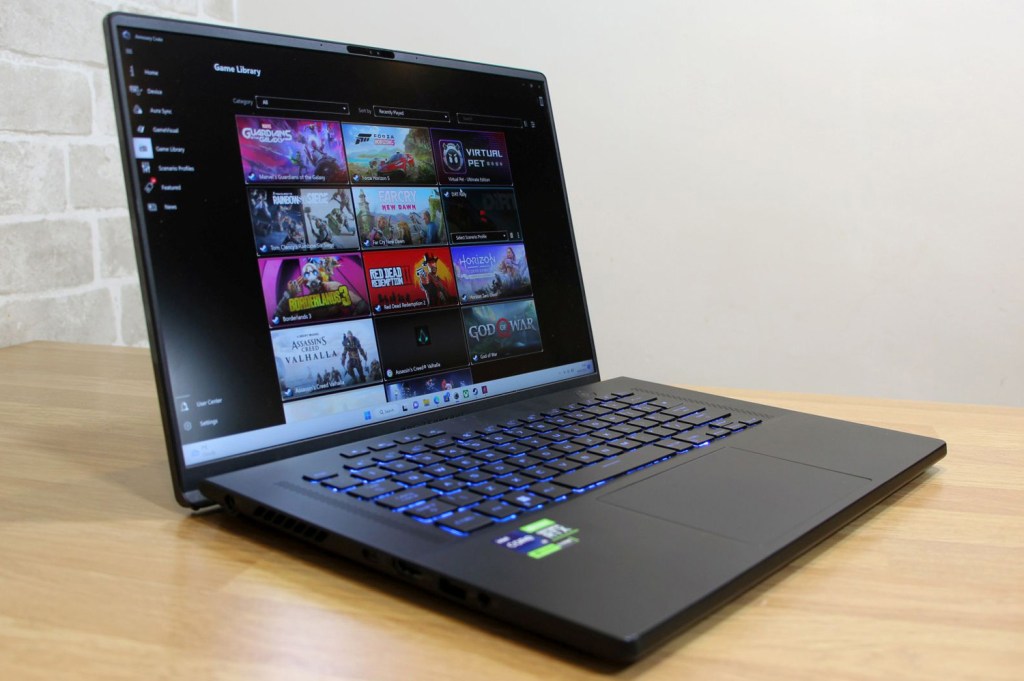
8. Asus ROG Zephyrus M16
Stuff Verdict
No shortage of gaming grunt, and the miniLED screen is amazing – but this slim, sturdy notebook will almost certainly be outpaced by beefier competitors
Pros
- Superb gaming and processing power
- A bold, high-quality Mini LED display
Cons
- Rivals will be even faster
- Mediocre connectivity and ergonomics
| Asus ROG Zephyrus M16 specs | |
|---|---|
| Screen | 16in, 2560×1600 Mini LED w/ 240Hz |
| CPU | Intel Core i9-13900H 14-core (6 performance, 8 efficiency), 2.6GHz |
| Memory | 32GB DDR5 |
| Graphics | Nvidia GeForce RTX 4090 16GB |
| Storage | 1TB |
| Operating system | Windows 11 Home |
| Battery life | Up to 5 hours |
| Dimensions | 355x246x22.9mm, 2.3kg / 13.98 x 9.69 x 0.90in, 5.07lbs |
The ROG Zephyrus M16 ticks a lot of boxes, impressing us in several key areas. Powered by the mighty RTX 4090, it delivers fantastic gaming performance, and the Core i9 processor breezes through even the most demanding desktop tasks. Add to that the stunning Mini LED screen, which is easily one of the best displays you’ll find on any gaming laptop right now, and you’ve got a seriously compelling machine. If you’re in the market for something slim, portable, and undeniably sharp-looking, you’d be hard-pressed to find a better option than the M16.
However, the compact size and lightweight design come with a few compromises. To keep everything sleek and portable, Asus has had to dial back a bit on performance. Don’t get us wrong – this laptop is no slouch, but some competitors (including Asus’ own no-holds-barred Strix models) will soon feature even more powerful GPUs and CPUs, along with superior connectivity options. Of course, those machines will also come with a bulkier build and a heftier price tag. Still, when you’re already investing this kind of money, it’s worth considering whether you’re after the absolute most power available, or if portability and style are more important to you.
For those seeking a portable powerhouse with enough muscle to handle any modern game, the Zephyrus M16 is an excellent choice. The AniMe Matrix LEDs on the lid might seem like a bit of a gimmick, but they’re fun, and they certainly add to the laptop’s unique aesthetic. If you don’t mind a few small compromises for the sake of portability, this is a seriously impressive gaming machine that won’t leave you disappointed.
- Read more: Asus ROG Zephyrus M16 review
Best gaming laptop for competitive Esports
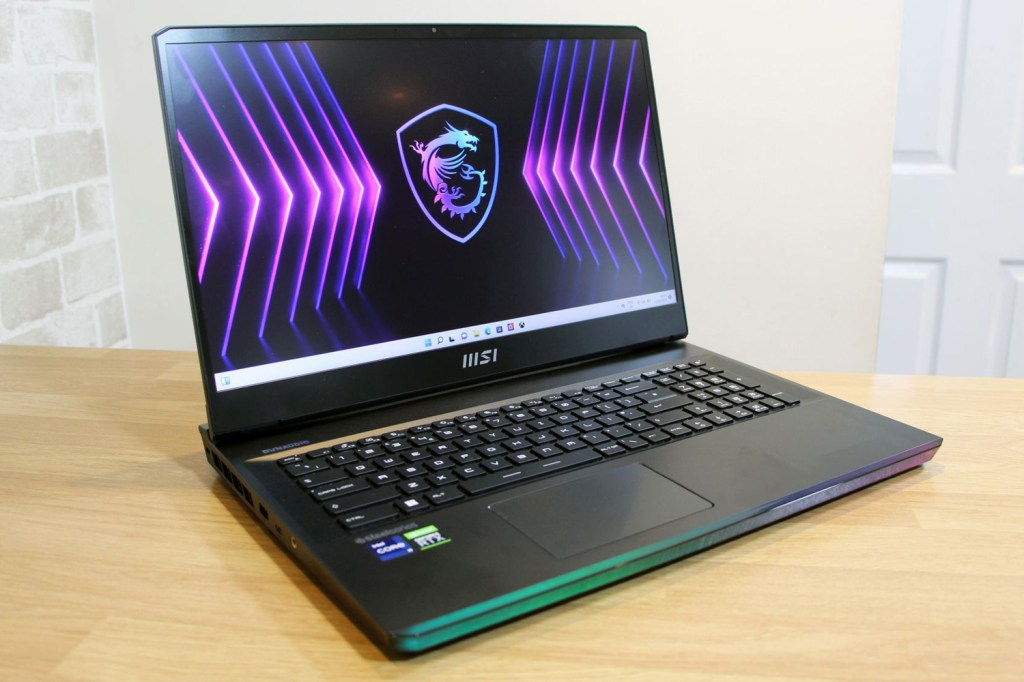
9. MSI Raider GE77
Stuff Verdict
It’s huge, heavy and expensive, but if you’ve got the cash then the MSI Raider GE77 delivers unprecedented power and impressive display quality.
Pros
- Incredible gaming and application speed
- High-quality 17.3in display
Cons
- Thick, heavy chassis
- Loud fan output in challenging situations
| MSI Raider GE77 specs | |
|---|---|
| Screen | 17.3in, 2,560 x 1,440 240Hz IPS |
| CPU | Intel Core i9 |
| GPU | Nvidia GeForce RTX 3080 Ti 16GB |
| RAM | 32GB |
| Storage | 1TB |
| Battery | Up to 5 hours |
| Dimensions | 397 x 284 x 26mm, 3kg / 15.63 x 11.18 x 1.02in, 6.61lbs |
This laptop is an absolute beast. It’s faster than nearly every other 17.3-inch notebook we’ve put through its paces, making it a serious contender in the high-performance gaming space. The screen delivers top-tier gaming visuals, the keyboard feels robust and responsive, and MSI has packed this machine with a wealth of ports and super-fast connectivity options. On top of that, the build quality is excellent, giving you a device that feels as durable as it is powerful.
That said, it’s not for the faint of heart – or for anyone with a weak back. This laptop is a bruiser, with a chassis that’s both thicker and heavier than most of its competitors. Lugging it around isn’t exactly fun, and when you’re running demanding games, it gets loud. If you’re sensitive to fan noise, you might need to invest in some noise-cancelling headphones. And let’s not forget the price tag: at nearly $4000/£4000, it’s a significant investment. You can find cheaper alternatives, like Alienware’s quieter and slimmer models, although they won’t come with a screen quite as impressive. Only Razer’s sleeker designs come in pricier, but those trade some of the raw power for elegance.
Ultimately, this kind of performance is always going to come with a steep price. The MSI Raider GE77 is like the muscle car of gaming laptops – it’s big, bold, and built for speed. If you’re after a machine that prioritises sheer power over portability and don’t mind the bulk (or the noise), then this could be perfect for you. For those who want something a little sleeker, other brands might tempt you, but for the power-hungry gamer, the Raider is hard to beat.
- Read more: MSI Raider GE77 review
Best designed gaming laptop
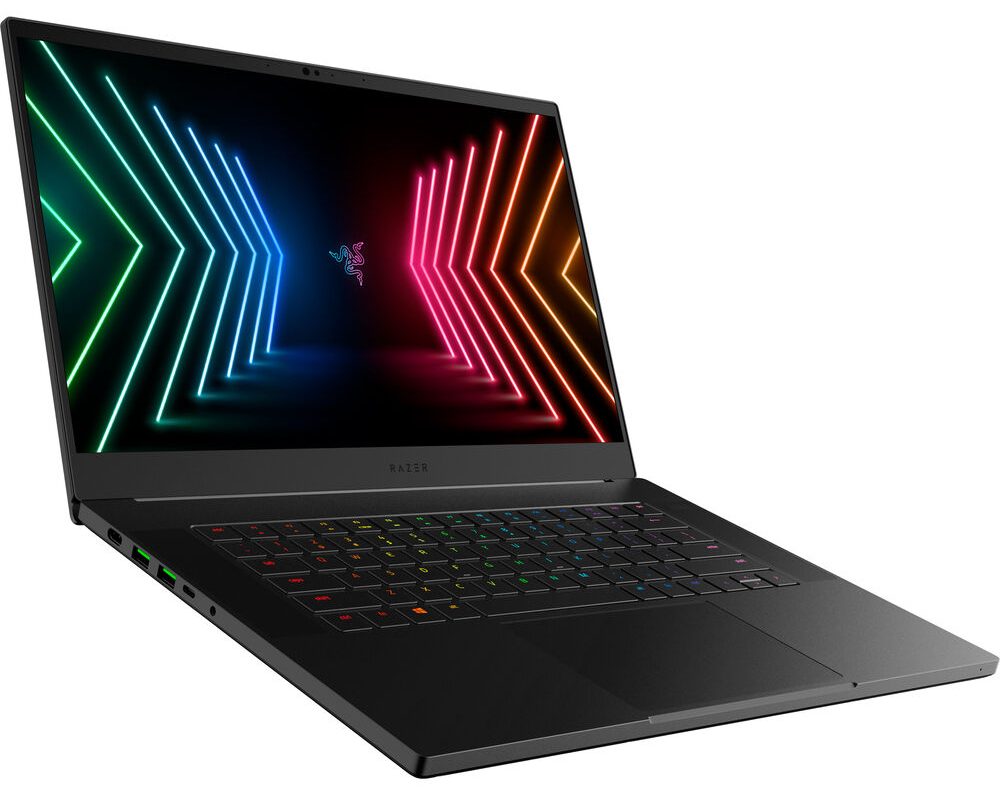
10. Razer Blade 15 Advanced
Stuff Verdict
Brilliant design meets searing pace in a top-tier esports experience.
Pros
- Good general spec sheet
- Not too noisy
Cons
- Not cheap
| Razer Blade 15 Advanced specs | |
|---|---|
| Screen | 15.6in 1920×1080 360Hz / 2560×1440 240Hz / 4K 144Hz |
| CPU | Intel Core i7/i9 |
| GPU | GeForce RTX 3060 6GB / 3080 Ti 16GB |
| RAM | 16-32GB |
| Storage | 1TB SSD |
| Battery | 1-4 hours |
| Dimensions | 17mm thick, 2.01kg / 0.67in, 4.43lbs |
Razer makes some of the best gaming laptops on the market, and its latest machines take aim at competitive gamers who want every advantage in top esports titles. That’s no surprise given the firm’s pedigree in peripherals – they’ve spent years building the best gaming mice and keyboards around.
The Razer Blade 15 Advanced uses lightning-fast 360Hz displays with 2ms response times, so there’s hardly any difference in performance between these screens and the best desktop displays.
Those 360Hz panels pair ace performance with excellent visuals, including 100% sRGB reproduction and high contrast – handy for seeing enemies lurking in the darkest corners. Alternative display specs are available: the 1080p, 240Hz variant has Nvidia G-Sync for smooth gaming, and the 4K model is ideal for creative work.
Razer’s machines have the internals to keep up with those displays. They’re bolstered by Nvidia’s latest GeForce RTX 3070 Ti and 3080 Ti GPUs, which deliver extra cores and higher clock speeds than non-Ti models, and they have 12th-gen Intel processors that have proven to be exceptional for gaming and working. There’s a lot to like around the rest of the specs too – like Thunderbolt 4 ports with charging, SD card slots, Killer Wi-Fi 6 and crisp RGB-lit keyboards.
The speakers are high-quality, and the 17mm body and 2.01kg weight mean this is slimmer and lighter than most 15.6in machines. The aluminium exterior does get warm in tough gaming situations, but it doesn’t bring too much fan noise.
The updated Blade 15 Advanced is not cheap: the most affordable model with a 12th-gen CPU costs around $3000/£3000. There are also 17.3in and 14in variants, but for us that 15.6in model with the 360Hz screen is the esports sweet spot.
Best cheap gaming laptop
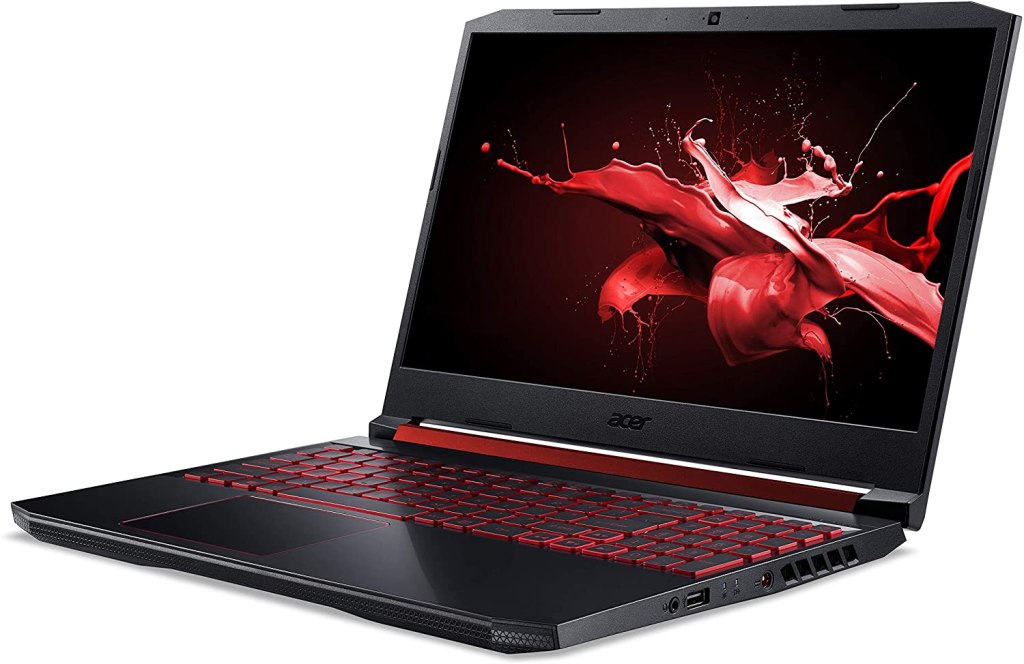
11. Acer Nitro 5
Stuff Verdict
Rough around the edges but offers outstanding value.
Pros
- Great value
- Powerful
Cons
- Average build quality
- Poor battery life
| Acer Nitro 5 specs | |
|---|---|
| Screen | 15.6in 1920×1080 144Hz |
| CPU | Intel Core i5/i7 / AMD Ryzen 5/7 |
| GPU | GeForce RTX 3050 4GB / 3070 8GB |
| RAM | 8/16GB |
| Storage | 512GB SSD |
| Battery | 1-3 hours |
| Dimensions | 24mm thick, 2.3kg / 0.94in, 5.07lbs |
If you’d like to get your hands on some top gaming power without rinsing your bank account, this Acer is our top budget pick. This machine is available with current-gen Nvidia graphics alongside capable Intel processors and displays with the refresh rates to handle games at decent speeds.
The most powerful Nitro 5 models pair the RTX 3070 GPU with AMD’s Ryzen 7 5800H. Those components supply enough gaming power to scythe through any title.
More affordable specs rely on RTX 3050 and 3060 graphics cores – the former is ideal for casual games and older titles, while the latter is a rock-solid chip for esports. The Intel options aren’t current-gen and can’t keep up with AMD, but they’re respectable and won’t slow you down… plus they’re getting updated later this year, which bodes well for performance.
The 15.6in displays have a 144Hz refresh rate – fine for most situations – and offer good depth and contrast. You get three full-size USB ports, an HDMI output, dual-band Wi-Fi 6 and Bluetooth, plus a keyboard with a numberpad and four-zone RGB LED lighting. Those buttons are fast and comfortable, so ideal for long gaming sessions.
The compromises? Build quality is mediocre, so we’d recommend a protective sleeve if you’ll travel with this notebook. Plus it’s heavy, the speakers are tinny and ours only lasted for just over 3hrs during a work benchmark.
Best gaming laptop for mid-range performance
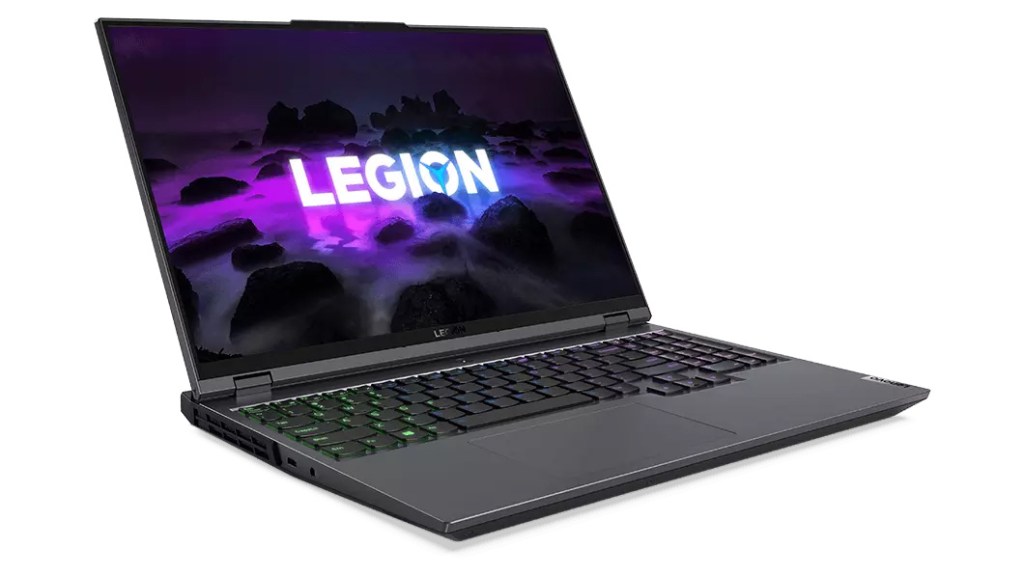
12. Lenovo Legion 5 Pro
Stuff Verdict
A big-screen experience with the power for games and creative work.
Pros
- Good for work and play
- Super display
Cons
- Refresh rate could be better
| Lenovo Legion 5 Pro specs | |
|---|---|
| Screen | 16in 2560×1600 165Hz |
| CPU | AMD Ryzen 5/7 |
| GPU | GeForce RTX 3050 Ti 4GB / 3070 8GB |
| RAM | 8-32GB RAM |
| Storage | 256GB-1TB SSD |
| Battery | 1-4 hours |
| Dimensions | 22mm thick, 2.54kg / 0.87in thick, 5.6lbs |
Loads of people buy a gaming laptop and also use it for work, which is no surprise given the ample power available in the latest game-centric portables. If you’re on the hunt for a machine that can straddle work and play, the Lenovo Legion 5 Pro does a tremendous job without costing silly money.
It’s got more screen space than most gaming laptops, and has some surprising features alongside plenty of power. And, crucially, it looks more ‘mature’ than most gaming notebooks so it won’t seem weirdly out of place in the office.
Lenovo’s machine has a load of features that boost its ability in work situations. The display has a 16in diagonal, a 16:10 aspect ratio and a 2560×1600 resolution, which means you get more vertical space and more pixels than most. It renders the sRGB colour gamut accurately, with great contrast, and it’s got awesome brightness levels that mean it works well outdoors.
Elsewhere, the Legion has loads of USB connections and a webcam with a privacy shutter and Windows Hello support. The keyboard is fast and comfy and includes a number pad.
On the inside, it’s available with AMD Ryzen 5 and Ryzen 7 processors, with the former suited to mainstream work and the latter a content-creation powerhouse. These rigs can run with up to 32GB of memory and 1TB of SSD space. It’s an impressive specification, especially when you consider that the Legion’s prices start at close to $1000/£1000 – and upgrades later in the year will see some models equipped with better processors, graphics cores and displays.
If you want to run top games without compromise you’ll need to specify an RTX 3080, and esports fans might not be happy with the 165Hz refresh rate. For most people, though, this is the best choice if you need a laptop for gaming and working.
What to consider when buying a gaming laptop
Gaming laptops are expensive so to ensure you’re not wasting your money there are several important factors to consider to ensure you get the best gaming experience for your needs and budget.
Without a doubt, the most important aspect of a gaming laptop is performance. If your budget allows, you’ll want to opt for a laptop with a powerful processor (such as Intel Core i9 or AMD Ryzen 9), a dedicated graphics card (NVIDIA GeForce GTX or RTX, or AMD Radeon), and sufficient RAM (at least 16GB, preferably 32GB).
These components will directly impact your gaming performance. The GPU, in particular, is crucial for gaming performance – it’s really important to ensure your laptop has a dedicated graphics card, as integrated graphics are not powerful enough for modern gaming.
Of course, with all this performance on tap your gaming laptop can get hot during intensive gaming sessions, so you’ll want to make sure it has an efficient cooling system. Good thermal management will prevent overheating and help maintain optimal performance.
You’ll want to check if the laptop allows for easy upgrades of components like RAM and storage, as this can extend the machine’s lifespan.
After decent performance, you’ll want to make sure your laptop has a good display – after all, you can’t upgrade this like you would a gaming PC build. Look for a laptop screen with a high refresh rate (at least 120Hz) and low response time, as this will provide a smoother and more responsive gaming experience.
You’ll want to opt for an SSD (Solid State Drive) rather than an HDD (Hard Disk Drive) as your primary storage, as SSDs are faster and improve loading times in games.
A comfortable and responsive keyboard is vital for gaming, so you’ll want to make sure you’re happy with the keyboard in your gaming laptop (as, like the display, this can’t be upgraded at a later date). You should keep in mind the layout, key travel, and whether it has customisable RGB lighting.
Now, gaming laptops are infamous for their poor battery life, so if you plan to use yours for tasks other than gaming you’ll want to look for a laptop with reasonable battery life. You can read our reviews to find out the models below performed when it comes to battery life.
Finally, you’ll want to think about the design and portability. Some gaming laptops can be quite bulky and heavy, so if you plan to travel with it regularly then look for a balance between portability and performance.
Likewise, some gaming laptops can be understated, but many are flashy with RGB lights and brash design flairs. If you’ll regularly be taking your laptop to work in an office, you may want to opt for a more understated design.
What are the best laptop accessories for gaming?
he best gaming laptop accessories can enhance your experience. A quality gaming mouse is a must, somehting which offers customisable buttons and precision tracking. An external mechanical keyboard can also improve your control, with brands like Corsair and SteelSeries offering great options.
A gaming headset with a built-in mic, such as the SteelSeries Arctis Pro, ensures immersive sound and clear communication. Cooling pads, like those from Cooler Master, help keep temperatures in check during intense gaming sessions. Finally, an external gaming monitor with a high refresh rate, like the ASUS TUF Gaming VG27AQ, can provide a bigger, smoother gaming display when you’re at home.
Do I need a 4K screen in my gaming laptop?
While 4K screens are visually stunning, they may not be necessary for everyone. For most gamers, a 1440p or even a 1080p screen with a high refresh rate (120Hz or above) can offer a better experience, especially for fast-paced games where fluidity matters more than pixel count.
4K requires a lot more GPU power, which could lead to reduced performance or require more expensive hardware. Additionally, on a laptop-sized display, the visual difference between 1440p and 4K is less noticeable than on a larger external monitor. Unless you’re doing professional creative work or absolutely need the best resolution, a 4K screen might be overkill for a gaming laptop.
What is the best brand for gaming laptops?
There isn’t a single “best” brand, but several stand out for different reasons. ASUS’s ROG (Republic of Gamers) line is highly regarded for its performance and build quality, with models like the Zephyrus often leading the pack. MSI also delivers strong gaming laptops, like the Titan and Raider series, known for their raw power. Razer’s Blade laptops are favoured for their sleek, premium designs, though they can be pricier. Alienware by Dell offers innovative designs and strong customer support. Each brand has its strengths, so it’s worth prioritising features like portability, performance, or aesthetics based on your needs.
Is it cheaper to build my own gaming laptop?
Building your own gaming laptop isn’t really an option the way it is with desktops. Laptops have highly integrated components, which means you can’t just buy parts off the shelf and assemble them yourself.
How we test gaming laptops
We’re avid gamers and have used and reviewed countless gaming laptops over the years. We’ve tried and tested most of the products above, and used a combination of our own experiences, specs, and reviews to pull together a list of what we believe to be the best gaming laptops for most people.
How do we review a gaming laptop? We’ll play games on them of course! We’ll test each laptop out with the latest AAA titles to see how they handle the most demanding games out there.
We’ve covered various form factors and budgets, and for more information on Stuff’s rating and review process, feel free to read our page on how we test products.


